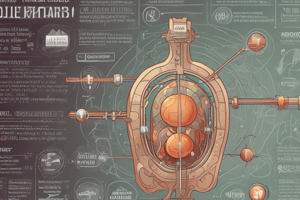Podcast
Questions and Answers
What does pharmacodynamics refer to?
What does pharmacodynamics refer to?
- The route of drug administration
- How the body metabolizes a drug
- The process of drug excretion
- What the drug does to the body (correct)
First-pass metabolism occurs when drugs are administered intravenously.
First-pass metabolism occurs when drugs are administered intravenously.
False (B)
What is the term for how the body bio-transforms a drug to aid in its excretion?
What is the term for how the body bio-transforms a drug to aid in its excretion?
Metabolism
The _____ is primarily responsible for the excretion of drugs from the body.
The _____ is primarily responsible for the excretion of drugs from the body.
Match the following pharmacology terms with their definitions:
Match the following pharmacology terms with their definitions:
Which of the following is NOT one of the R's of Drug Administration?
Which of the following is NOT one of the R's of Drug Administration?
Bioavailability is only concerned with the amount of the drug that is left in the body after excretion.
Bioavailability is only concerned with the amount of the drug that is left in the body after excretion.
What is the main purpose of excretion in pharmacology?
What is the main purpose of excretion in pharmacology?
What is the primary purpose of nebuliser administration?
What is the primary purpose of nebuliser administration?
Subcutaneous injections have a faster absorption rate than intramuscular injections.
Subcutaneous injections have a faster absorption rate than intramuscular injections.
What is the recommended oxygen flow rate for nebuliser administration?
What is the recommended oxygen flow rate for nebuliser administration?
Injections should be avoided in areas of ______ tissue, bruises, infections, or broken skin.
Injections should be avoided in areas of ______ tissue, bruises, infections, or broken skin.
Match the injection type with its property or characteristic:
Match the injection type with its property or characteristic:
Which injection site is typically used for intramuscular administration?
Which injection site is typically used for intramuscular administration?
It is necessary to wipe the injection site for a healthy patient.
It is necessary to wipe the injection site for a healthy patient.
What angle is the needle usually inserted at for subcutaneous injections?
What angle is the needle usually inserted at for subcutaneous injections?
In the procedure for injections, the nurse should hold the syringe in their ______ hand.
In the procedure for injections, the nurse should hold the syringe in their ______ hand.
What is a potential risk of gluteal injections?
What is a potential risk of gluteal injections?
Which patient characteristic can lead to a faster elimination of medication?
Which patient characteristic can lead to a faster elimination of medication?
Adverse effects of medication are always benign.
Adverse effects of medication are always benign.
What is the primary site of drug absorption for orally administered medications?
What is the primary site of drug absorption for orally administered medications?
The ______ is the latest possible date at which a medication can be safely administered.
The ______ is the latest possible date at which a medication can be safely administered.
Match the following routes of drug administration with their characteristics:
Match the following routes of drug administration with their characteristics:
What can cause a delay in drug elimination in elderly patients?
What can cause a delay in drug elimination in elderly patients?
Food interactions can impact the efficacy of a drug.
Food interactions can impact the efficacy of a drug.
What must be calculated for pediatric drug dosages?
What must be calculated for pediatric drug dosages?
Drug ______ refers to how it works to create the desired effect.
Drug ______ refers to how it works to create the desired effect.
Match the following drug preparations with their examples:
Match the following drug preparations with their examples:
Which method of drug administration avoids first-pass metabolism?
Which method of drug administration avoids first-pass metabolism?
Volume and dose refer to the same quantity in medication.
Volume and dose refer to the same quantity in medication.
What does contraindication mean in medication administration?
What does contraindication mean in medication administration?
Intraosseous administration delivers drugs directly into the ______.
Intraosseous administration delivers drugs directly into the ______.
Flashcards are hidden until you start studying
Study Notes
Pharmacology
- The study of drugs: their uses, effects, and modes of action.
Pharmacokinetics
- How the body affects a drug (absorption, distribution, metabolism, and excretion).
Pharmacodynamics
- How a drug affects the body.
Absorption
- How a drug enters the body (route of administration).
Distribution
- Where a drug goes in the body and where it accumulates.
Metabolism
- How the body bio-transforms a drug to remove it.
- Involves chemical alteration of drug molecules to make them more water-soluble for excretion.
Elimination
- The process of a drug being bio-transformed from an active state to inactive metabolites.
Excretion
- The removal of drugs from the body, either as metabolites or unchanged drugs.
- Primarily performed by the kidneys.
Half-Life
- The time it takes for the concentration of a drug in the plasma or the total amount in the body to be reduced by 50%.
First Pass Metabolism
- Drugs administered orally are metabolized in the gut or liver before reaching systemic circulation.
Bioavailability
- The extent and rate at which the active drug or metabolite enters systemic circulation and reaches the site of action.
The R's of Drug Administration
- Right drug
- Indications and contraindications
- Appearance of the drug
- Right route
- Correct pathway for drug administration
- Right patient
- Age, other diseases, allergies, and potential side effects of the drug
- Right dose
- Drug calculations
- Right time
- Scheduled administration, rate of administration, and time for effect
- Right to refuse
- Consent if appropriate
- Action if incorrect drug administration is suspected
- Right response
- Desired outcome of medication administration
- Right documentation
- Accuracy records
- Right to question, advice, and knowledge
- Confirm with partner
- Advise patient of possible side effects
Patient Characteristics Affecting Medications
- Age
- Children have less developed liver function, leading to quicker drug elimination.
- Elderly may have compromised organ function or multiple co-morbidities, resulting in slower drug elimination.
- Body weight
- Higher body weight require higher doses for effect due to changes in drug clearance.
- Pathophysiology
- Disease, infection, and inflammation can decrease drug metabolism, affecting the duration of drug effect.
- Genetics
- Impact on drug metabolism.
- Drug or food interactions
- Certain drugs may be contraindicated if taken with other drugs, over-the-counter medications, or herbs.
Important Definitions
- Dose: The amount of medication to be given.
- Weight: The physical weight of the active dose of the medication.
- Volume: The physical volume of the fluid containing the medication.
- Expiry date: The latest date for safe administration of the medication.
- Route of administration: How the drug enters the body.
- Actions: The desired effect of the drug.
- Mechanism of action: How the drug works to create the effect.
- Indications: Conditions for which the medication is appropriate.
- Contraindications: Conditions where the medication is unsafe.
- Precautions: Conditions requiring close monitoring or cautious administration.
- Adverse effects: Negative or undesired effects of the medication.
- Side effects: Benign effects of the medication unrelated to its therapeutic effects.
Drug Dose & Volume
- Dose refers to the mass of drug required, regardless of preparation or form.
Paediatrics
- Paediatric drug dosage is based on patient weight.
- Three calculations for paediatric drug administration:
- Patient weight
- Drug dose based on weight
- Volume based on drug dose
Calculating Doses
- Three formats for calculating drug doses:
- mg/kg
- µg/kg
- mL/kg
Calculating Volume
- Drug preparation refers to the dosage and volume in the ampoule.
- Factors involved in volume calculation:
- Volume of drug preparation required
- Dosage (mass) of drug required
- Concentration of the preparation provided
Drug Administration
Enteral Methods
- Drug is placed directly into the GI tract.
- Sublingual: Under the tongue
- Oral: Swallowed
- Rectal: Administered as a suppository
Parenteral Methods
- Drug is delivered into systemic circulation bypassing the intestinal mucosa.
- Topical: Used externally on skin, nose, eyes
- Intradermal: Into the skin
- Subcutaneous: Under the skin
- Intramuscular: Into the skeletal muscle
- Intravenous: Directly into the bloodstream
- Endotracheal: Administered endotracheally through an ET tube
- Intraosseous: Directly into bone marrow
- Intranasal: Administered through nasal structures
- Inhalation: Through airways and into alveoli
- Vaginal: Administered into the vagina
Oral Administration
- Most common route in community settings.
- Primary drug absorption site: small intestine.
- Bioavailability is influenced by the first-pass effect.
- Examples: paracetamol, ibuprofen, aspirin
Sublingual Administration
- Under the tongue for absorption through the mucous membranes of the mouth.
- Bypasses first-pass metabolism, leading to higher bioavailability.
- Examples: glyceral trinitrate (GTN), anginine
Intranasal Administration
- Aerosol medication applied through the nose.
- Advantages: easily accessible and highly vascular.
- Contraindications:
- Suspected nasal fractures
- Obstructed nasal passage
- Complications:
- Underdose if not administered properly
- Mild, short-lasting discomfort (typically burning)
Nebuliser administration
- Converts liquid medication into an aerosol mist for inhalation.
- Rapidly absorbed across the respiratory tract epithelium.
- Administered through a mask with an oxygen flow rate of 6-8 L/min.
- Patient must be sitting.
Subcutaneous Injection
- Delivery of medication into the fat layer between the skin and muscle.
- Slower absorption than intramuscular route.
- Example: insulin, heparin
- Factors affecting absorption:
- Exercise
- Environmental temperature
- Contraindications:
- Injection into scar tissue, bruises, infection, or broken skin.
- Precautions:
- Pain
- Bleeding
Intramuscular Injection
- Administration of medication into the muscle.
- Rapid setup and administration.
- Commonly used sites: deltoid muscle (shoulder) and vastus lateralis (outer side of thigh).
- Contraindications:
- Evidence of infection or trauma at the injection site.
- Precautions:
- Pain
- Bleeding
- Abscess
- Cellulitis
- Tissue necrosis
Studying That Suits You
Use AI to generate personalized quizzes and flashcards to suit your learning preferences.




